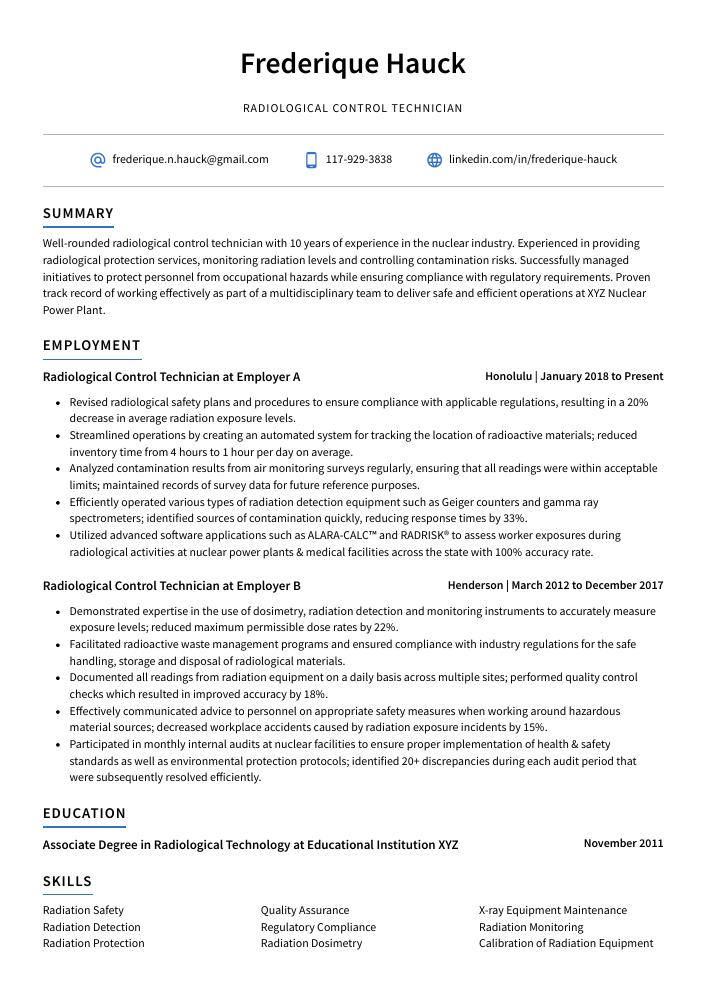Radiological Control Technician Resume Guide
Radiological Control Technicians are responsible for monitoring, controlling and assessing radiation levels in the workplace. They develop safety protocols to reduce employee exposure to hazardous materials and keep records of all tests conducted. Additionally, they inspect equipment regularly for any potential hazards or malfunctions that may increase radiation levels.
You have the expertise to become a radiological control technician in no time, but employers don’t know who you are. To make them aware of your skills and experience, you must write a resume that stands out from the competition.
This guide will walk you through the entire process of creating a top-notch resume. We first show you a complete example and then break down what each resume section should look like.
Table of Contents
The guide is divided into sections for your convenience. You can read it from beginning to end or use the table of contents below to jump to a specific part.
Radiological Control Technician Resume Sample
Frederique Hauck
Radiological Control Technician
[email protected]
117-929-3838
linkedin.com/in/frederique-hauck
Summary
Well-rounded radiological control technician with 10 years of experience in the nuclear industry. Experienced in providing radiological protection services, monitoring radiation levels and controlling contamination risks. Successfully managed initiatives to protect personnel from occupational hazards while ensuring compliance with regulatory requirements. Proven track record of working effectively as part of a multidisciplinary team to deliver safe and efficient operations at XYZ Nuclear Power Plant.
Experience
Radiological Control Technician, Employer A
Honolulu, Jan 2018 – Present
- Revised radiological safety plans and procedures to ensure compliance with applicable regulations, resulting in a 20% decrease in average radiation exposure levels.
- Streamlined operations by creating an automated system for tracking the location of radioactive materials; reduced inventory time from 4 hours to 1 hour per day on average.
- Analyzed contamination results from air monitoring surveys regularly, ensuring that all readings were within acceptable limits; maintained records of survey data for future reference purposes.
- Efficiently operated various types of radiation detection equipment such as Geiger counters and gamma ray spectrometers; identified sources of contamination quickly, reducing response times by 33%.
- Utilized advanced software applications such as ALARA-CALC™ and RADRISK® to assess worker exposures during radiological activities at nuclear power plants & medical facilities across the state with 100% accuracy rate.
Radiological Control Technician, Employer B
Henderson, Mar 2012 – Dec 2017
- Demonstrated expertise in the use of dosimetry, radiation detection and monitoring instruments to accurately measure exposure levels; reduced maximum permissible dose rates by 22%.
- Facilitated radioactive waste management programs and ensured compliance with industry regulations for the safe handling, storage and disposal of radiological materials.
- Documented all readings from radiation equipment on a daily basis across multiple sites; performed quality control checks which resulted in improved accuracy by 18%.
- Effectively communicated advice to personnel on appropriate safety measures when working around hazardous material sources; decreased workplace accidents caused by radiation exposure incidents by 15%.
- Participated in monthly internal audits at nuclear facilities to ensure proper implementation of health & safety standards as well as environmental protection protocols; identified 20+ discrepancies during each audit period that were subsequently resolved efficiently.
Skills
- Radiation Safety
- Quality Assurance
- X-ray Equipment Maintenance
- Radiation Detection
- Regulatory Compliance
- Radiation Monitoring
- Radiation Protection
- Radiation Dosimetry
- Calibration of Radiation Equipment
Education
Associate Degree in Radiological Technology
Educational Institution XYZ
Nov 2011
Certifications
Radiation Safety Officer Certification
American Board of Health Physics
May 2017
1. Summary / Objective
A resume summary or objective should provide the employer with a snapshot of your qualifications and experience as a radiological control technician. In this section, you can highlight key skills such as knowledge of radiation safety protocols, proficiency in using specialized equipment for measuring radiation levels, and ability to work independently or collaboratively on projects. You could also mention any certifications related to working with hazardous materials that you possess.
Below are some resume summary examples:
Professional radiological control technician with 5+ years of experience in the nuclear power industry. Adept at conducting radiation surveys, identifying and fixing radiological hazards, preparing reports and monitoring safety protocols. Seeking to join ABC Power Plant as a radiological control technician where I can use my background knowledge to ensure compliance with regulations while keeping workers safe from hazardous exposure.
Energetic Radiological Control Technician with 8+ years of experience in industrial radiation safety. Skilled at providing technical guidance for the safe and efficient use of radioactive materials, monitoring work areas to ensure compliance with applicable regulatory requirements, and educating workers on radiological protection methods. At XYZ achieved a 25% reduction in staff exposure levels through improved training protocols.
Enthusiastic and highly skilled radiological control technician with 8+ years of experience in nuclear engineering. Proven track record of developing and implementing safety protocols, monitoring radiation levels, and providing technical support to ensure compliance with all applicable regulations. Seeking to join ABC Tech as the next RC Technician where I can use my expertise to promote a safe working environment for personnel.
Determined and detail-oriented Radiological Control Technician with 7+ years of industry experience. Highly knowledgeable in radiation safety principles and best practices, as well as the operation and maintenance of radiological equipment. Demonstrated ability to identify potential hazards and develop solutions for mitigating risk. Experienced in creating reports that meet requirements set by regulatory agencies such as OSHA.
Dependable and highly knowledgeable Radiological Control Technician with 10+ years of experience in radiation safety and protection. Proven track record of detecting, measuring, evaluating and monitoring sources of ionizing radiation to ensure compliance with regulations. Seeking a position at ABC Company where I can leverage my expertise to keep all personnel safe from the harmful effects of radiation exposure.
Accomplished radiological control technician with 12+ years of experience in radiation safety and environmental protection. Achieved multiple certifications from the Nuclear Regulatory Commission (NRC) to safely manage nuclear waste disposal for ABC Corporation. Proven success in reducing risks associated with radioactive materials by 30% through implementation of best practices, training, and inspections.
Driven radiological control technician with 5+ years of experience in the nuclear industry. Experienced in monitoring activities and areas to ensure safety and compliance standards are met, as well as conducting radiation surveys for high-level radioactive waste sites. Expertly trained in gamma spectroscopy, alpha/beta counting techniques, radiochemistry analysis, and other radiological methods.
Seasoned radiological control technician with 8+ years of experience in nuclear power plant operations and maintenance. Seeking to join ABC Nuclear Power Plant to ensure safe and compliant radiation protection practices. At XYZ, identified a critical flaw in the radiological system that resulted in 50% fewer incidents of overexposure among personnel.
2. Experience / Employment
The employment (or experience) section is where you talk about your work history. It should be written in reverse chronological order, with the most recent job listed first.
Stick to bullet points for this section; doing so makes it easier for the reader to quickly take in what you have to say. When writing each point, make sure that you provide detail and explain what tasks were completed and any results achieved from them.
For example, instead of saying “Performed radiation surveys,” you could say, “Conducted daily radiation surveys using a Geiger counter throughout multiple areas of the facility; identified potential safety hazards which led to corrective actions being taken.”
To write effective bullet points, begin with a strong verb or adverb. Industry specific verbs to use are:
- Monitored
- Inspected
- Calibrated
- Analyzed
- Assessed
- Operated
- Recorded
- Tested
- Evaluated
- Investigated
- Implemented
- Adjusted
- Programmed
- Troubleshot
- Documented
Other general verbs you can use are:
- Achieved
- Advised
- Compiled
- Coordinated
- Demonstrated
- Developed
- Expedited
- Facilitated
- Formulated
- Improved
- Introduced
- Mentored
- Optimized
- Participated
- Prepared
- Presented
- Reduced
- Reorganized
- Represented
- Revised
- Spearheaded
- Streamlined
- Structured
- Utilized
Below are some example bullet points:
- Accurately measured and analyzed radiation levels within a 30-mile radius of the plant, reducing radiation exposure risks by 15%.
- Formulated detailed reports on survey results to assess compliance with state and federal regulations; identified over 40 non-compliance issues that were addressed in subsequent monitoring periods.
- Investigated potential contamination sources, conducted decontamination procedures as needed and monitored personnel for any adverse reactions or health effects due to radiation exposure.
- Assessed safety protocols for radiological equipment used at various facilities across the company’s network; improved overall efficiency by 10% through optimized processes & procedures implementation.
- Represented the organization at industry conferences, provided expert testimony in court cases related to occupational exposures & illustrated safe work practices during training sessions/seminars attended by new hires.
- Implemented radiological control protocol in a medical setting, monitoring radiation levels and ensuring safety standards of up to 8 facilities were met on a daily basis.
- Mentored colleagues in radiological safety procedures; increased their knowledge base by 25% and improved overall efficiency by 15%.
- Diligently monitored radiation activities for personnel, equipment and materials using dosimetry systems; reduced average exposure time per person from 4 hours to 2 hours within 6 months.
- Programmed laboratory computers with specialized software to analyze radiographic images for accuracy; generated $5,000 in additional revenue due to enhanced quality assurance measures over the course of 1 year.
- Calibrated electronic instruments used for measuring gamma rays & x-rays according to prescribed standards; decreased calibration errors by 35% during routine maintenance checks each month.
- Introduced new procedures to maintain radiation safety in the workplace, resulting in a 30% reduction of radiation exposure for personnel.
- Compiled accurate records and reports on daily radiological surveys, dosage measurements and contamination levels; monitored trends over time to ensure compliance with state regulations.
- Evaluated equipment performance according to established standards and calibrations; identified potential risks associated with non-compliant items and took corrective actions promptly.
- Reliably operated various types of detectors such as Geiger Counters & Dosimeters when conducting routine air sampling tests across multiple departments within the facility; documented results accurately every hour on average during each shift worked.
- Monitored decontamination areas regularly to identify sources of radioactive materials present that require special handling or disposal; provided training sessions for personnel regarding these practices as needed.
- Adjusted radiological control instrumentation and equipment to ensure radioactive sources complied with safety regulations; lowered radiation levels by 25% in 6 months.
- Troubleshot malfunctions of radiological instruments, repaired components as necessary and identified ways to improve the accuracy of readings.
- Achieved compliance with all regulatory requirements related to environmental protection from exposure to ionizing radiations at the workplace site; reduced employee health risks by 20%.
- Presented monthly reports on radiation monitoring results for management review and updated operating procedures accordingly; improved record-keeping efficiency by 30%.
- Competently operated a wide range of equipment such as Geiger counters, gamma ray spectrometers & surface contamination monitors while ensuring safe working conditions at all times.
- Improved radiological safety by conducting regular inspections and tests on radiation sources, identifying potential risks before they occurred and implementing corrective measures to reduce risk levels by 30%.
- Spearheaded the development of a comprehensive radiological control program encompassing policies, procedures & protocols for handling radioactive materials; lowered incidents of contamination accidents by 40%.
- Consistently monitored worker exposure to hazardous industrial radiations using dosimeters, film badges & other measuring devices; reduced employee exposure limits from 10 mSv/yr to 4 mSv/yr as required under government regulations.
- Coordinated with senior management and external stakeholders such as local authorities in ensuring that all operations were compliant with applicable laws related to health protection against ionizing radiations; averted numerous costly legal penalties totalling $20K+.
- Structured periodic training courses for workers in proper handling techniques when dealing with radiation sources and installed modern protective equipment which decreased overall workplace injury rate by 25%.
- Reorganized existing radiological control processes and procedures to improve safety, reduce contamination levels by 40%, and save an estimated $2,500 in costs annually.
- Optimized radiation monitoring equipment performance through regular calibration checks; identified faults early on that helped avoid potential delays of up to 8 hours during critical operations.
- Substantially improved operational efficiency by creating detailed written SOPs for the entire team; trained over 45 technicians on correct usage of radiological protection devices within 3 months time frame.
- Advised management on best practices for working with hazardous materials when constructing containment walls or other structures around radioactive sources; reduced risk exposure levels by 55%.
- Developed a comprehensive training program to educate staff members about safe handling techniques and proper decontamination protocols while working with ionizing radiation sources; increased overall safety awareness across the organization by 30%.
- Expedited radiological surveys by 20%, ensuring that all safety protocols and procedures were met with minimal disruption to the production workflow.
- Reduced radiation exposure levels in the workplace by 70% through regular monitoring of equipment, personnel and materials using specialized instruments such as Geiger counters and rem meters.
- Confidently operated radioactive material transfer systems from receiving to disposal sites, including transportation of hazardous waste containers; disposed safely over 200 lbs of irradiated materials per month for two years consecutively.
- Inspected X-ray machines, CT scanners and other radiographic devices regularly for any malfunctions or irregularities within their control panels [20+ times a week].
- Operated gamma cameras used in medical imaging studies on patients while applying appropriate shielding measures; took 10+ images daily without compromising patient’s health or safety at any stage during the process.
- Meticulously monitored radiation levels in the workplace, ensuring that they remained within safety standards and reducing potential health risks by 20%.
- Tested laboratory equipment for radioactivity contamination prior to use; identified 3 defective pieces of equipment, allowing it to be replaced timely and avoiding costly repairs or further damage.
- Prepared detailed reports on daily radiologic activity readings including exposure times and dose rates; enabled prompt corrective actions when deviations were detected.
- Recorded all observations accurately in logbooks for future reference and compliance with regulatory requirements; lowered audit findings by 15%.
3. Skills
Skill requirements will differ from employer to employer – this can easily be determined via the job advert. Organization ABC may require knowledge of radiation safety and Organization XYZ may need expertise in radiation detection.
It is essential to tailor the skills section of your resume to each job that you are applying for because many employers use applicant tracking systems these days, which scan resumes for certain keywords before passing them on to a human.
Once listed here, you can further elaborate on your skillset by discussing it in more detail in other areas such as the summary or experience sections.
Below is a list of common skills & terms:
- Calibration of Radiation Equipment
- Nuclear Medicine Imaging
- Quality Assurance
- Radiation Detection
- Radiation Dosimetry
- Radiation Monitoring
- Radiation Protection
- Radiation Safety
- Regulatory Compliance
- X-ray Equipment Maintenance
4. Education
Including an education section on your resume will depend on how far along you are in your career. If you just graduated and have no work experience, mention your education below your resume objective. However, if you have significant work experience to showcase, omitting the education section is perfectly fine.
If an education section is included, try to mention courses or subjects related to radiological control technician roles that demonstrate relevant knowledge and skills for the job at hand.
Associate Degree in Radiological Technology
Educational Institution XYZ
Nov 2011
5. Certifications
Certifications demonstrate to potential employers that you have the necessary skills and knowledge for a given field. Having certifications from recognized organizations is an excellent way to show your commitment to professional development and staying up-to-date with industry trends.
Including any relevant certifications on your resume can help give you an edge over other applicants, so make sure to list them if they are applicable!
Radiation Safety Officer Certification
American Board of Health Physics
May 2017
6. Contact Info
Your name should be the first thing a reader sees when viewing your resume, so ensure its positioning is prominent. Your phone number should be written in the most commonly used format in your country/city/state, and your email address should be professional.
You can also choose to include a link to your LinkedIn profile, personal website, or other online platforms relevant to your industry.
Finally, name your resume file appropriately to help hiring managers; for Frederique Hauck, this would be Frederique-Hauck-resume.pdf or Frederique-Hauck-resume.docx.
7. Cover Letter
Cover letters are a great way to make your job application stand out from the crowd. They are usually made up of 2 to 4 paragraphs and provide an opportunity for you to explain why you’d be the perfect fit for the role.
Unlike resumes, cover letters allow recruiters and hiring managers to get a better understanding of who you are as a professional and what makes you unique. Not all jobs require one, but having one could help increase your chances of landing an interview.
Below is an example cover letter:
Dear Jess,
I am writing to apply for the Radiological Control Technician position at XYZ Corporation. As a certified technician with experience working in both hospital and industrial settings, I am confident that I would be a valuable asset to your team.
In my current role as a radiological control technician at ABC Hospital, I am responsible for conducting daily surveys of the facility to ensure compliance with state and federal regulations. I also perform monthly audits of our radiation safety program and provide training to new staff on proper safety procedures. In addition, I have experience conducting research on new radiological safety technologies and making recommendations on their implementation.
During my time at XYZ Corporation, I gained extensive experience working with radioactive materials in an industrial setting. In this role, I was responsible for developing and implementing safe work practices for employees who were exposed to radiation. In addition, I conducted regular inspections of work areas and equipment to ensure compliance with safety standards. My knowledge of federal regulations related to radiation exposure has helped me prevent potential accidents and incidents at both facilities where I have worked.
I am confident that my skills and experience will enable me to make a positive contribution to your organization if given the opportunity. Please find attached a copy of my resume for your review; you can reach me by phone or email if you have any questions or would like additional information about my qualifications.”
Sincerely,
Frederique
Radiological Control Technician Resume Templates
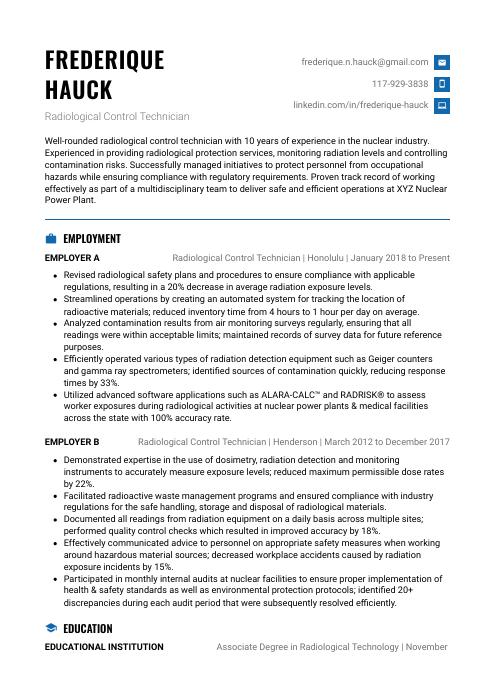 Echidna
Echidna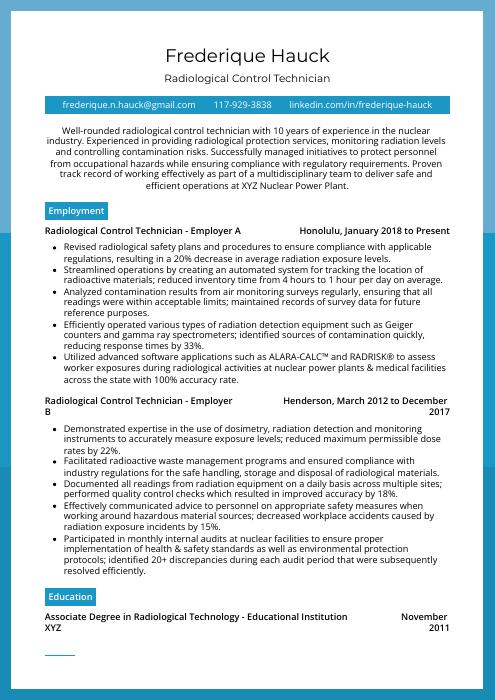 Rhea
Rhea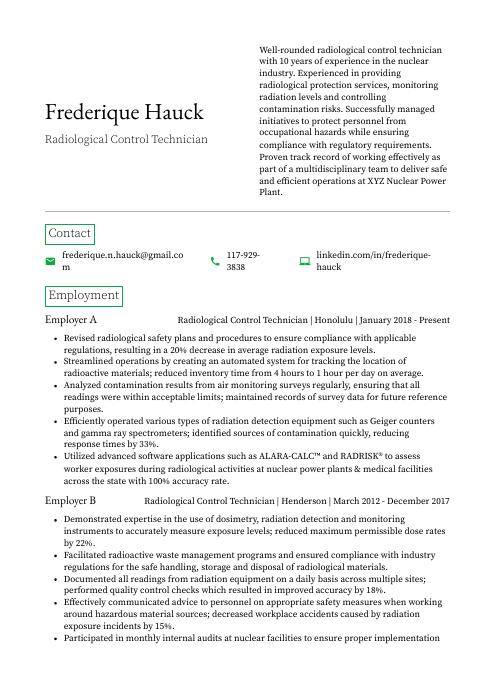 Quokka
Quokka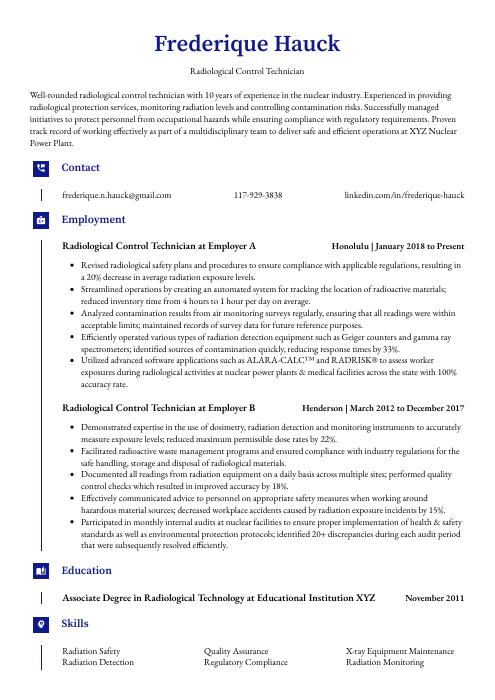 Gharial
Gharial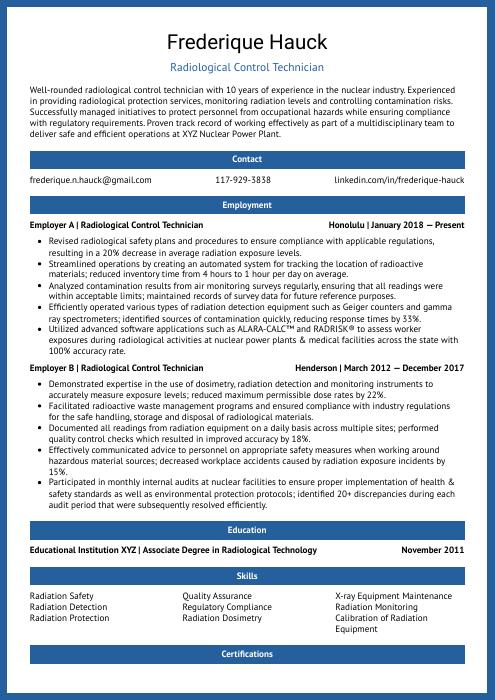 Ocelot
Ocelot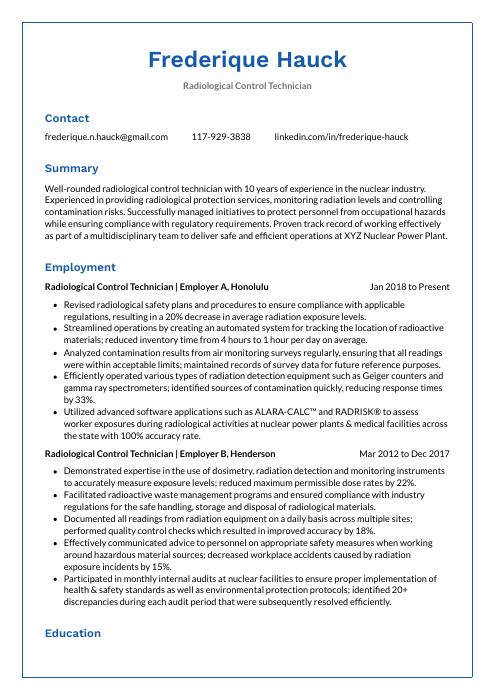 Markhor
Markhor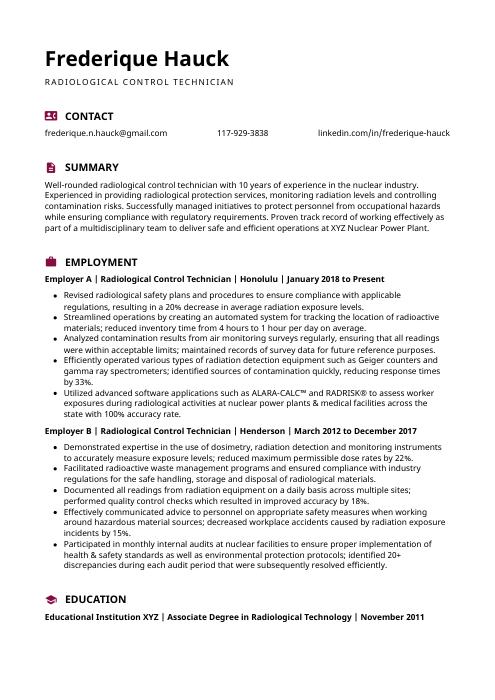 Hoopoe
Hoopoe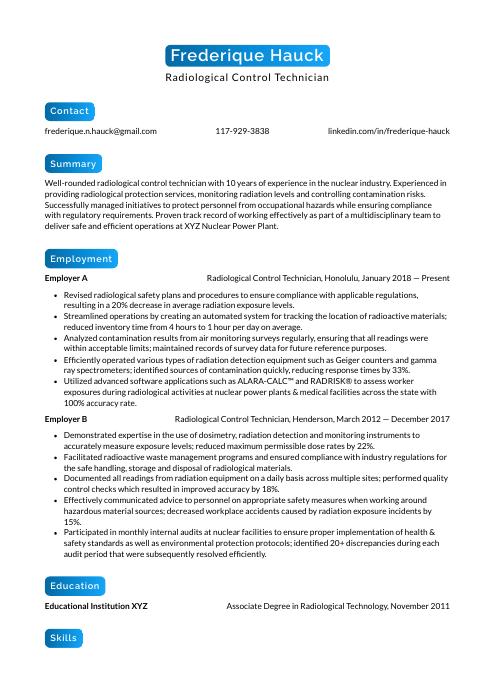 Kinkajou
Kinkajou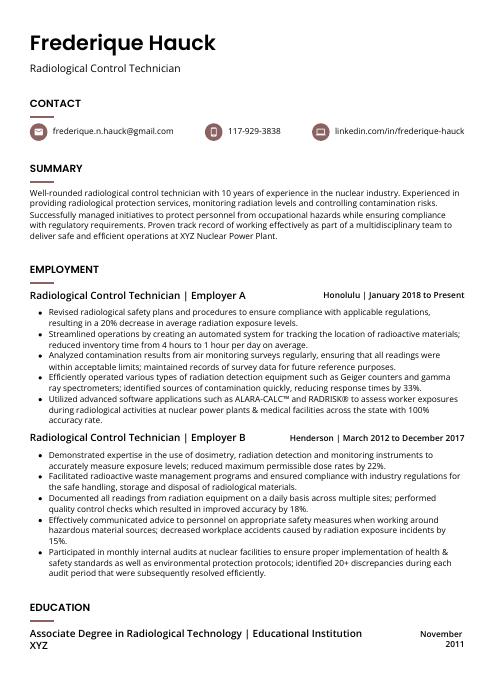 Fossa
Fossa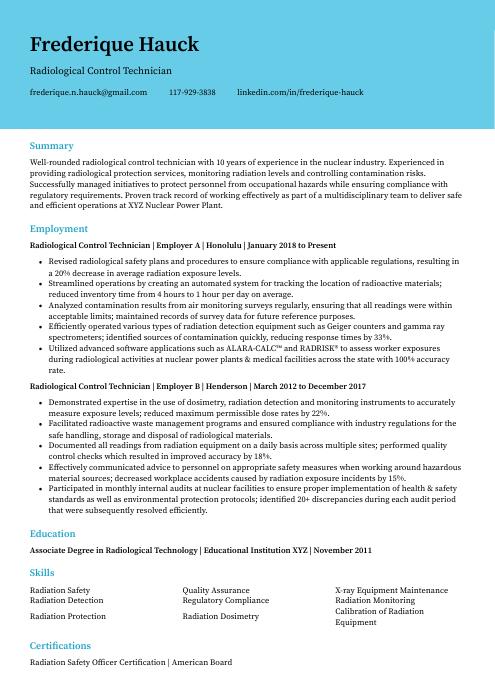 Dugong
Dugong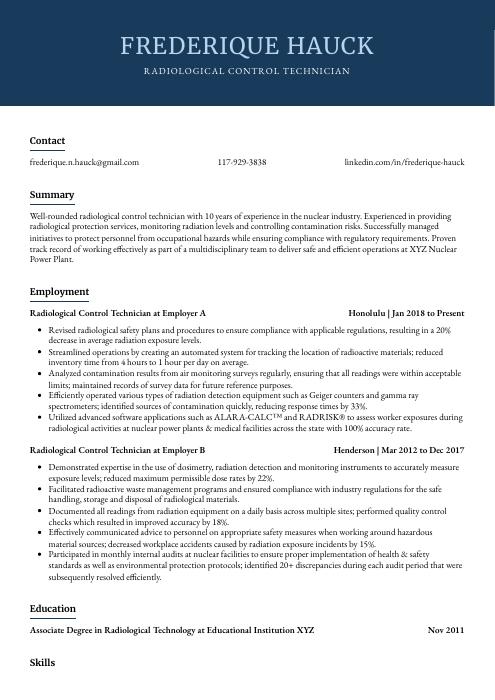 Bonobo
Bonobo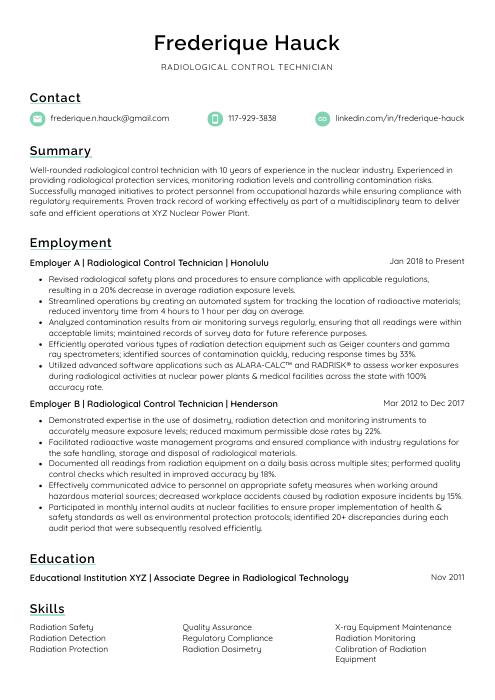 Lorikeet
Lorikeet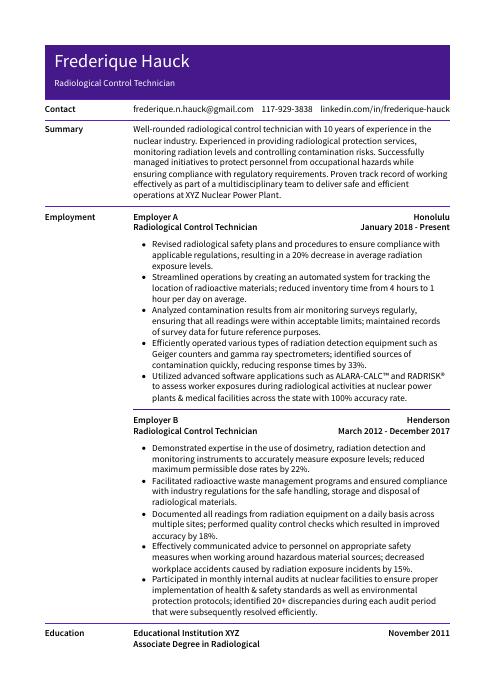 Pika
Pika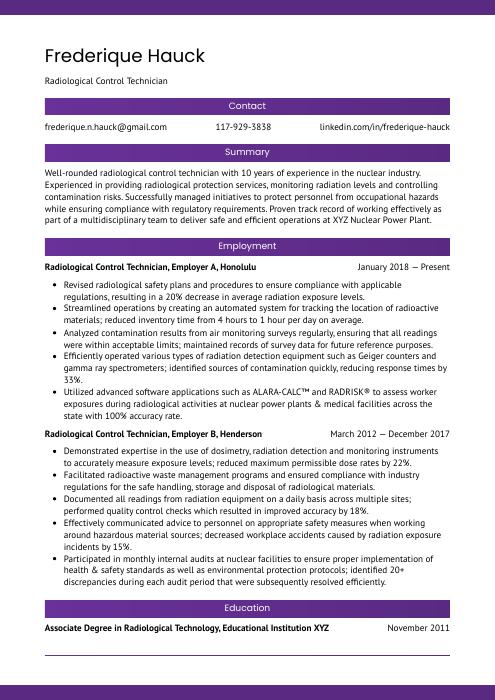 Jerboa
Jerboa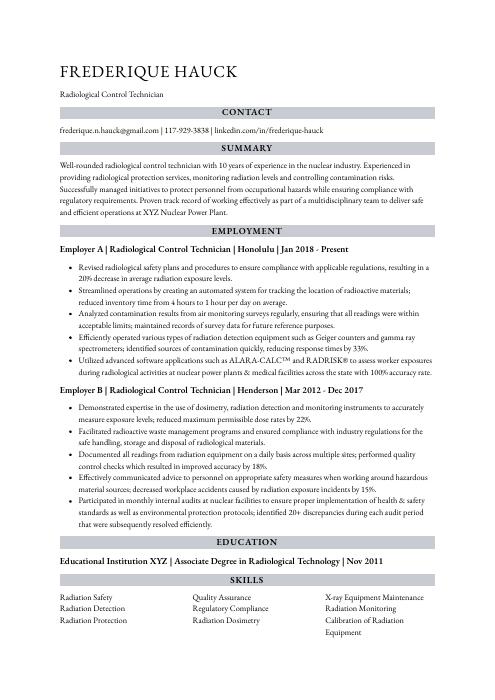 Numbat
Numbat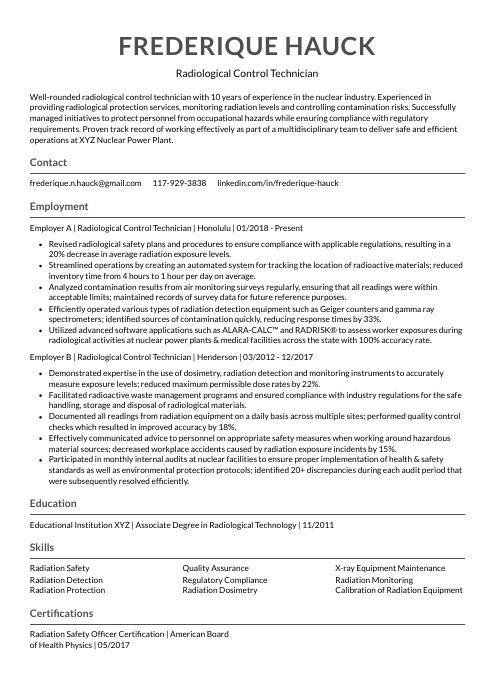 Indri
Indri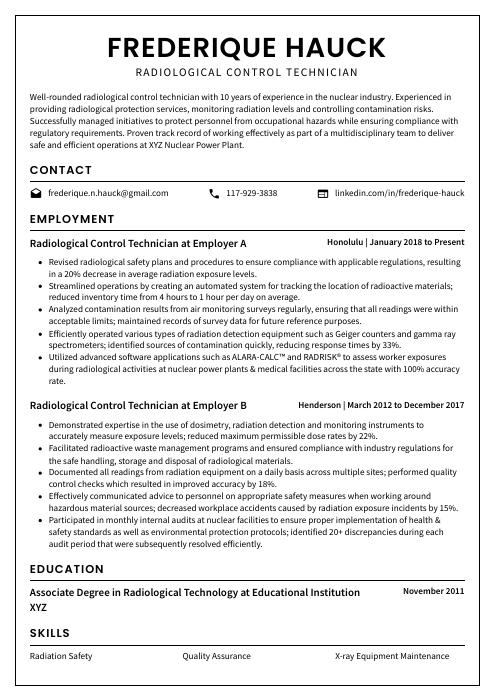 Cormorant
Cormorant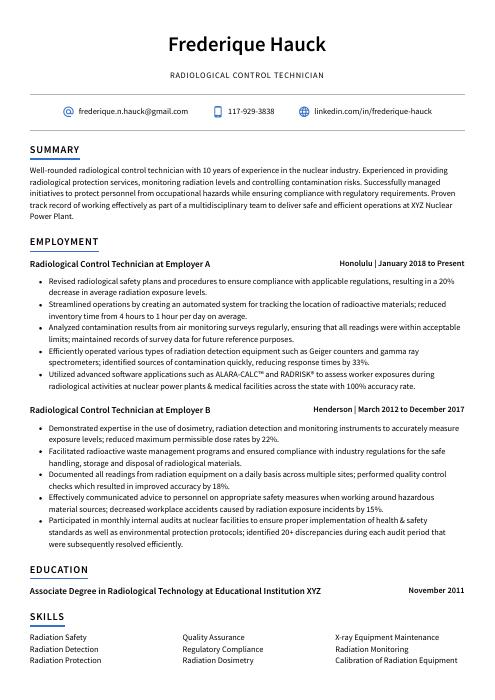 Axolotl
Axolotl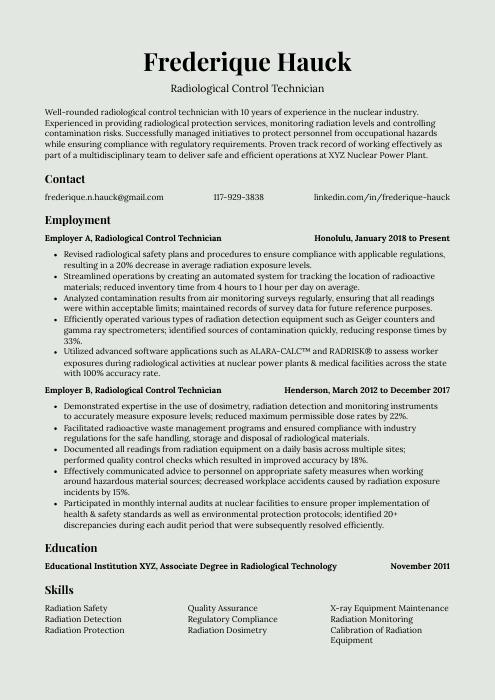 Saola
Saola Rezjumei
Rezjumei
